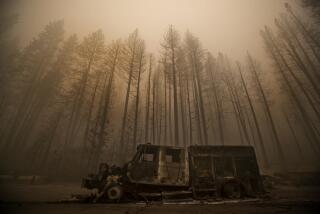After devastating Atlas fire, utility crews work to restore power to 29,000 customers

As an incident commander for Pacific Gas & Electric, Robert Cupp has seen the devastation fire can inflict on a community.
He worked on rebuilding the grid after the Rim fire, one of the largest in state history. And he helped Lake County reconnect after the deadly Valley fire destroyed neighborhoods.
“They all have their unique personalities,” Cupp, 49, said.
If there was a personality to the Atlas fire burn area, it’d be a temperamental one.
Cupp and PG&E officials avoid providing estimates on when they’ll have all of Napa County online.
“We’re going to be here until we’re done,” Cupp says.
Crews on the ground say that’s weeks away — at least for some areas. About 93% of PG&E customers have had power restored, but about 29,000 customers remain without electricity or gas.
No cause for the fire has been determined, and the company will not speculate, said PG&E spokeswoman Andrea Menniti.
“In regards to the investigation, in some cases we have found instances of wires down, broken poles and impacted infrastructure,” she said in a statement. “Where those have occurred, we have reported them to our state utility regulator and CalFire.”
On Sunday, hundreds of PG&E workers and subcontractors motored across the county in massive caravans of blue trucks with equipment and big rigs hauling power poles as tall as trees.
An estimated 3,000 people are operating out of four base camps covering Napa, Sonoma, Mendocino and Yuba counties, where many of them eat, sleep and work for days at a time.
The Santa Rosa camp in Sonoma County is the largest because that community sustained the most damage, with thousands of homes burned in a matter of hours.
In just over a day in Napa County, where Cupp is supervising the Atlas fire recovery, the utility set up a 40-acre base surrounded by vineyards waiting to be harvested.
Hundreds of workers’ personal vehicles were parked in dusty rows like a scene from an outdoor music festival. A few steps away were eight big rig trailers outfitted as sleeping quarters similar to what one would find on a Navy ship. They hold 330 people, Menniti said.
At the entrance, a security guard checked credentials and controlled traffic between inbound and outbound crews. Behind him was a stack of wooden power poles that crews could haul back out to the burn area.
Cupp estimated the company will use 400 to 600 new poles for Napa County alone. Each one has to be outfitted with specific equipment depending on whether it’s hooked up to a home or business and its location on the grid, he said. The poles are trucked in from suppliers in Fresno, Marysville and Fremont.
But installing the pole is just the final part of a very long process, he said.
Days before a pole is installed and an area reconnected, crews have to go out and assess the damage.
On Saturday, teams were working up and down Atlas Peak Road, chopping down trees that were compromised by the fire or otherwise in the way of the new infrastructure to come.
After the trees are cut, new holes have to be dug. That can take considerably longer if crews have to cut through rock, Cupp said.
Napa County is blessed in some areas with soft, diggable soil and cursed in others with hard, volcanic rock.
On good ground, a team can install three or four poles in a day, he said. The power lines are then energized once CalFire gives the approval, Cupp said.
A “micro-base” is also in the works near Atlas Peak, PG&E said.
Twitter: @JosephSerna
More to Read
Start your day right
Sign up for Essential California for news, features and recommendations from the L.A. Times and beyond in your inbox six days a week.
You may occasionally receive promotional content from the Los Angeles Times.







